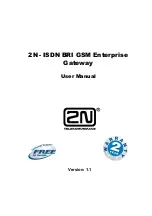
A
CCESS
G
ATEWAY
Introduction
33
Load Rebalancing upon Link Recovery
Load balancing and failover with well-configured link availability detection provides fast and
effective recovery from ISP link failure occurrences. Additional consideration must be made as
to what actions should be taken when a failed ISP link recovers. The Nomadix approach is to
rebalance as the ISP links change, thus making sure the maximum level of service is always
provided. There is a small yet important waiting time to ensure changing links is kept to a
minimum.
Load Balancing and Failure Considerations
1.
Is load balancing or just ISP failover required?
2.
Is aggregation of multiple low-speed links required?
3.
How reliable are different local ISP services?
4.
What are the relative costs of different ISP services?
5.
Do ISP links need to be shared between guest and back-office users?
6.
Is there a requirement to have certain users connected to a particular ISP?
1. It may be a requirement to provide just a backup service to the primary ISP service in the
case that the main HSIA ISP fails. The backup service may be on a pay-to-use basis through a
3G or 4G wireless modem, or be a low-cost, lower-tier service, such as a cable modem service,
that is only used when the main ISP link is down, on the basis that providing a reduced HSIA
service is better than no service at all when the main ISP link is down. Alternatively, the
organization may have multiple ISP links, and wants to be able to fully utilize all of them
under normal conditions. The Nomadix NSE supports both failover only and combined load
balancing with failover.
2. In some instances, suitable high-speed internet services required to meet the aggregate needs
of the organization may not be available or are simply too expensive. In this case it may be
desirable to aggregate multiple lower-cost, lower-speed lines together. The Nomadix AG2400
and AG5600 can aggregate services from up to three ISP links, and the AG5800 can handle up
to five links.
3. It is important to consider the relative quality of each ISP link. If a second link is much
lower quality than the main ISP link, then it should only be used as a back-up link in failover
mode, and not in a load-balanced environment. If the quality of the links is much the same,
then load balancing with failover should be used.
4. It is important to consider the relative cost of links. If all links have a fixed monthly charge,
then ideally they should be used in a load-balanced mode, so that costly links are not sitting
unused most of the time. But if an ISP link has a relatively low monthly charge with high per-
megabyte data usage charges, then it should only be used in failover mode as a backup to a
main ISP link.
Summary of Contents for Access Gateway
Page 1: ......
Page 12: ...ACCESS GATEWAY xii ...
Page 51: ...ACCESS GATEWAY Introduction 39 ...
Page 84: ...ACCESS GATEWAY 72 Installing the Access Gateway ...
Page 90: ...ACCESS GATEWAY 78 Installing the Access Gateway ...
Page 95: ...ACCESS GATEWAY System Administration 83 ...
Page 96: ...ACCESS GATEWAY 84 System Administration ...
Page 146: ...ACCESS GATEWAY 134 System Administration ...
Page 161: ...ACCESS GATEWAY System Administration 149 ...
Page 185: ...ACCESS GATEWAY System Administration 173 ...
Page 205: ...ACCESS GATEWAY System Administration 193 The Network Interfaces screen appears ...
Page 310: ...ACCESS GATEWAY 298 The Subscriber Interface ...
Page 376: ...This page intentionally left blank ACCESS GATEWAY 364 Troubleshooting ...
Page 378: ...This page intentionally left blank ACCESS GATEWAY 366 ...
















































